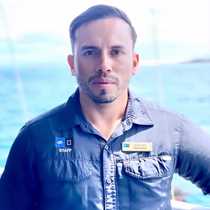Chinese Hat and Sullivan Bay
Today we went on a pre-breakfast Zodiac ride along a young lava field from 1968 on the coast of Santiago Island, also known as James Island. During the ride we were lucky to spot some Galápagos penguins, which were fishing early in the morning. Striated herons were also spotted on the black lava.
Later in the day, we went into the amazing Galápagos underwater world and snorkeled with marine iguanas feeding underwater. We also saw about five white-tipped reef sharks resting on the bottom, marbled rays, penguins swimming near snorkelers and a wide variety of colorful fish. I must say this was an outstanding snorkeling opportunity where some of us got to swim with sharks for the first time.
It was a perfect day with a beautiful sun that invited us to stay at the beach on Chinese Hat. While some of us were swimming a group of about six penguins came near the shoreline as they were chasing small fish. The fact that we saw so much in the water this morning was fascinating, and we could easily understood how Galápagos is known for its marine life.
The National Geographic Islander navigated near Bainbridge Islets and all our guests were invited to the sky deck to spot some greater flamingos, which were feeding in a lagoon found in the middle of one of the islets. Many flamingos were spotted before we continued our navigation to Santiago Island.
During the afternoon an adventurous walk was offered at Sullivan Bay, a young lava field where humans travel back in time to understand better how the Galápagos looked in the beginning. The process of primary succession appeared to be just beginning at this site. Some small pioneer plants were found among the rusty lava. We also found the endemic lava cactus, which only grows in the youngest areas of the Galápagos. A moonscape visitor site with a beautiful sunset marked the end of another day in the enchanted archipelago.




